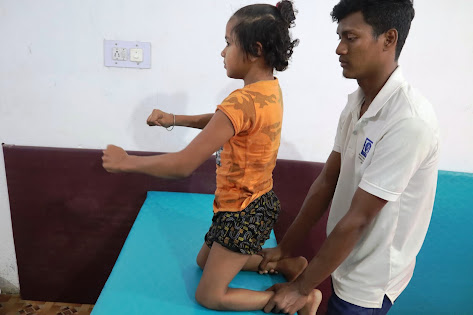ATAXIC CEREBRAL PALSY THERAPY PATTERNS
THERAPEUTIC INTERVENTION
FOR
"ATAXIC CEREBRAL PALSY"
1. Therapy Program for Ataxic Cerebral Palsy
Ataxia refers to incoordination, problems in balancing or being “without order.” Where, Ataxic cerebral palsy only affects an estimated 5 to 6 percent of cerebral palsy, is caused by injury to the cerebellum and is named for the uncoordinated and uncontrolled movements it causes.
These issues are due to damage to the motor control centers of the developing brain. Children with Ataxic cerebral palsy have a hard time controlling their movements. They are unstable and struggle with precise movements, such as writing and holding small objects. Ataxic CP can affect the hands, feet, eyes and even the ability to speak.
Like all other forms of cerebral palsy, Ataxic CP is a developmental disorder that affects the precise movement (motor function) of a specific function of the muscle. Ataxic cerebral palsy is characterized by problems with balance and coordination.
Physiotherapy and occupational therapy plays a vital role and as a cornerstone of all for development though therapy for children with cerebral palsy. Therapeutic intervention brings development of small muscles and postural tone of ataxic cerebral palsy. This type of therapy teaches children with daily living skills, such as eating, dressing bathing and developing social life skills. These children can also learn techniques that can help make some tasks easier by bringing better coordination of eyes and limbs. Splints may also be used during occupational therapy to make people who have ataxic cerebral palsy to become more independent.
Disorders that arise due to Ataxic cerebral palsy can cause difficult physical movements that will directly impact a child’s lives and its proper development. However, this impact can be greatly reduced with early intervention, proper treatment and skilled therapeutic interventions.
2. Therapy pattern for Ataxic cerebral palsy
Core exercises involve balancing and coordinating motor skills.
a. Body Balance and Body Strengthening Exercises
- Squatting exercise
- Standing from squatting position
- Kneeling upright
- Ball side rolling
- Walking with in parallel
- lower limb active strengthening and hip rotation exercise
b. Bolster therapy, for body stability and neck control
- Sitting to standing with Bolster
- Squatting with Bolster
- Supine to sitting with Bolster
- Gait training
C. Hand function activities
3. Conclusion:
Cerebral Palsy is a diverse group characterized by delayed body function, disorders and neurological that is non-progressive. Although the clinical picture may change as the brain matures. There is a need to know the associated signs and symptoms. Diagnosis and thorough testing is needed to know the exact problem in a child affected by cerebral palsy.
Cerebral palsy children require a complex health care team for identification, assessment, therapy intervention and follow-up with these children that gives them the best quality of life they can have.
Early physiotherapy and occupational therapy interventions provide an opportunity for the child to practice functional activities, body positions and develop proper gait pattern. By practicing meaningful and effective skills in a variety of environments, the child will have the opportunity to acquire skills that encourage them to be more independent with the activity of daily living and to increase their level of participation in society.
Therefore, effective therapy plan for children with cerebral palsy focuses on promoting functional independence and preventing further muscle weakness by applying needful exercises according the condition.








